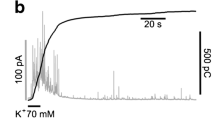Abstract
From a biophysical standpoint, data relevant to chemotransduction in the carotid body are difficult to interpret and there is no coherent scheme relating membrane properties of type I cells to the chemoreception process. Thus, while the membrane potential of type I cells has been reported to be independent of extracellular K+ (Baron and Eyzaguirre, 1977), these cells nonetheless exhibit a Ca++-dependent release of dopamine (DA) when exposed to K+-rich media (Almaraz et al., 1985). When challenged by chemoreceptor stimuli (low PO2 or pH, high PCO2, drugs, etc.), the membrane properties of these cells (i.e., membrane potential, specific membrane resistance and capacitance) exhibit changes of variable magnitude and direction, with no clear or consistent pattern for any given stimulus (Baron and Eyzaguirre, 1977: Eyzaguirre et al., 1983). Such observations render it difficult to formulate a unified concept of the biophysical aspects of chemotransduction.
Access this chapter
Tax calculation will be finalised at checkout
Purchases are for personal use only
Preview
Unable to display preview. Download preview PDF.
Similar content being viewed by others
References
Almaraz, L., Gonzalez, C. and Obeso, A. (1985). J.Physiol. (in press).
Baker, P.R. and Knight, D.E. (1984). Trends Neurosci., 7, 120–126.
Baker, P.F. and Rink, T.J. (1975). J.Physiol., 253, 593–620.
Baron, M. and Eyzaguirre, C. (1977). Am.J.Physiol., 233 (Cell Physiol. 2), C35–C46.
Douglas, W.W., Taraskevich, P.S. and Tomiko, S.A. (1983). J.Physiol., 338, 243–257.
Eyzaguirre, C., Monti-Bloch, L., Hayashida, Y. and Baron, M. (1983). In, Physiology of the Peripheral Arterial Chemoreceptors, H. Acker and R.G. O’Regan (eds.), Elsevier, Amsterdam, pp. 59-88.
Fidone, S.J., Gonzalez, C. and Yoshizaki, K. (1982). J.Physiol (London), 333, 93–110.
Fleming, R.M. and Clark, W.G. (1970). J.Cromat., 52, 305–312.
Freedman, S.B., Dawson, G., Villereal, M.L. and Miller, R.J. (1984). J.Neurosci., 4, 1453–1467.
Kilpatrick, D.L., Slepetis, R.J., Corcoran, J.J. and Kirshner, M. (1982). J.Neurochem. 38, 427–435.
Kostyuk, P.G. (1981). Biochem.Biophys.Acta, 650, 128–150.
Ritchie, A.K. (1979). J.Physiol. (London), 286, 541–561.
Rubin, R.P. (1982). Calcium and Cellular Secretion, Plenum Press, New York.
Author information
Authors and Affiliations
Editor information
Editors and Affiliations
Rights and permissions
Copyright information
© 1987 J.A. Ribeiro and David J. Pallot
About this chapter
Cite this chapter
Obeso, A., Fidone, S., Gonzalez, C. (1987). Pathways for Calcium Entry into Type I Cells: Significance for the Secretory Response. In: Ribeiro, J.A., Pallot, D.J. (eds) Chemoreceptors in Respiratory Control. Springer, Dordrecht. https://doi.org/10.1007/978-94-015-1155-1_10
Download citation
DOI: https://doi.org/10.1007/978-94-015-1155-1_10
Publisher Name: Springer, Dordrecht
Print ISBN: 978-94-015-1157-5
Online ISBN: 978-94-015-1155-1
eBook Packages: Springer Book Archive




